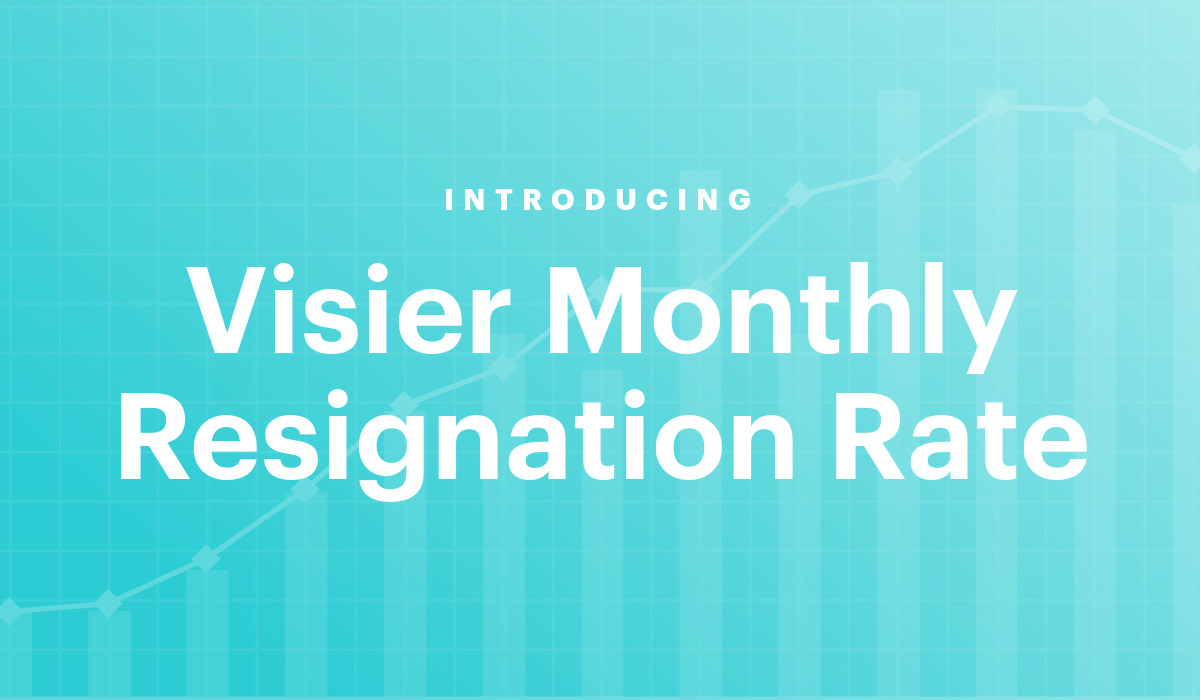Visier Launches a Monthly Resignation Rate Benchmark to Track Employee Turnover
Employee turnover has a huge effect on workforce budgets. Get the monthly resignation rate at Visier.com so you can make better decisions.

Visier is pleased to announce the launch of the Visier Monthly Resignation Report, a new resource that offers the most up- to- date view of employee resignation trends. This new report will let you stay informed of resignation trends in a timely manner and compare how your business performs against the benchmark and market trends. This report allows you to explore monthly trends across industries, and learn about the profile of those who resigned.
How the Visier Monthly Resignation Report can help your business
Monitoring the resignation trends in the overall market provides an important context for the decisions your business makes regarding its people. Increasing overall rates lead to an increasing volume of new job opportunities, which may cause your own people to resign. Decreasing employee turnover rates can indicate a level of uncertainty or caution in a specific industry sector.
The most value comes from being able to monitor your own rates relative to the market. Comparing your employee turnover rate versus benchmarks will shed light on how market changes impact the dynamics within your employee population. Identifying how closely your resignation rate tracks the market could indicate the effectiveness of your employee value proposition. This knowledge will help your organization’s leaders proactively retain the people that make you successful.
Real-time insights from a sea of data
Currently, 2022 employee turnover rates are still above those for 2019, indicating resignations continue to exceed their long term average. Certain sectors with large hourly workforces are seeing reductions in rates. Rates for sectors that rely on knowledge work remain elevated, with the largest increases (over their 2019 rates) among workers who are over 30 years old, or have more than five years of tenure.
Check out the latest Visier Monthly Resignation Report for the most recent findings.
Employee turnover continues to be a hot topic for business leaders. Before 2020, unemployment was at its lowest point since the 1960s, and the majority of the hiring (95%) was done to fill existing positions. Then came the so-called Great Resignation–which talent acquisition departments found less-than-great. Suddenly a huge number of employees started resigning, moving to new companies, and sometimes even resigning from their new position.
With the wave of employee turnover showing no signs of waning, replacing this lost talent while also hiring for the new and emerging skills needed to recover in a post-pandemic world has become a business imperative.
The impact of employee turnover
Losing an employee through resignation can be costly for organizations. Lost productivity, time to source, hire, and onboard a replacement, as well as the loss of the departing employees’ institutional knowledge and professional networks lead to substantial direct and indirect costs. The average cost to replace a knowledge worker is frequently cited as being up to one-and-a-half times an employee’s annual salary.
What can employee turnover data tell us?
Employee turnover data is important for budget planning and for an organization to know if it has the people needed to meet its goals. Understanding the resignation patterns in your business is as essential as understanding your cash flow. Retention is so important that many organizations begin to use people analytics specifically to uncover the drivers of employee turnover within their company.
Better predictions make it easier to match workforce supply with demand. Expect too little attrition, and the organization will fall behind on hiring and workforce productivity will drop. Forecast too much attrition, and the organization will waste money ramping up talent acquisition programs.
Accurate predictions are the cornerstone of effective workforce analysis and planning. Even a small increase in accuracy means significant savings, given that the workforce accounts for the biggest slice of the budget for most organizations. This explains, in part, why there has been so much interest on this topic in the past few years.
A note about our data: Many statistics like these live in the Visier Community dataset, which holds more than 15-million anonymized employee records. The companies supplying these data represent a wide range of industries. These insights are based on events data that is directly sourced from our clients. Because this information is so wide-reaching, yet anonymized to protect privacy, it provides an objective view of current trends. Visier analyses are powered by world class data science.


